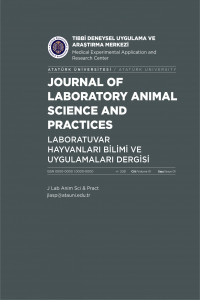Naringin is a Possible Protective Agent in a Rat Model of Polymicrobial Sepsis
Objective: The current study aimed to investigate the potential protective effect, the levels of some inflammatory cytokines, and the activities of oxidative stress markers of naringin, which is a flavonoid, on a rat model of polymicrobial sepsis-induced kidney injury. Method: Thirty (n=30) Wistar albino rats were randomly divided into five groups. The inflammatory cytokine levels were measured by enzyme-linked immunosorbent assay technique. Oxidative stress parameters were measured by tissue biochemistry. Results: Cecal-ligation and puncture sepsis led to a dramatic increase in all pro-inflammatory
cytokine levels, and naringin applications led to an important decrease in the levels of inflammatory cytokines in a dose-dependent manner. Additionally, naringin caused an increase in the
enzyme activities of malondialdehyde and superoxide dismutase and a decrease in the level of glutathione. Conclusion: Natural products especially flavonoids have the potential to be a protective agent in
sepsis-induced organ injury models. In our study, we preferred to use naringin as a natural agent and detected that it affected the inflammatory cytokine levels and oxidative stress enzyme activities. Further detailed studies should be performed to investigate the molecular mechanisms of the anti-inflammatory and antioxidant effects of naringin.
Naringin is a Possible Protective Agent in a Rat Model of Polymicrobial Sepsis
Objective: The current study aimed to investigate the potential protective effect, the levels of some inflammatory cytokines, and the activities of oxidative stress markers of naringin, which is a flavonoid, on a rat model of polymicrobial sepsis-induced kidney injury. Method: Thirty (n=30) Wistar albino rats were randomly divided into five groups. The inflammatory cytokine levels were measured by enzyme-linked immunosorbent assay technique. Oxidative stress parameters were measured by tissue biochemistry. Results: Cecal-ligation and puncture sepsis led to a dramatic increase in all pro-inflammatory cytokine levels, and naringin applications led to an important decrease in the levels of inflammatory cytokines in a dose-dependent manner. Additionally, naringin caused an increase in the enzyme activities of malondialdehyde and superoxide dismutase and a decrease in the level of glutathione. Conclusion: Natural products especially flavonoids have the potential to be a protective agent in sepsis-induced organ injury models. In our study, we preferred to use naringin as a natural agent and detected that it affected the inflammatory cytokine levels and oxidative stress enzyme activities. Further detailed studies should be performed to investigate the molecular mechanisms of the anti-inflammatory and antioxidant effects of naringin.
___
- 1
- 2
- 3
- 4
- 5
- 6
- 7
- 8
- 9
- 10
- 11
- 12
- 13
- 14
- 15
- 16
- 17
- 18
- 19
- 20
- 21
- 22
- 23
- 24
- 25
- 26
- 27
- 28
- 29
